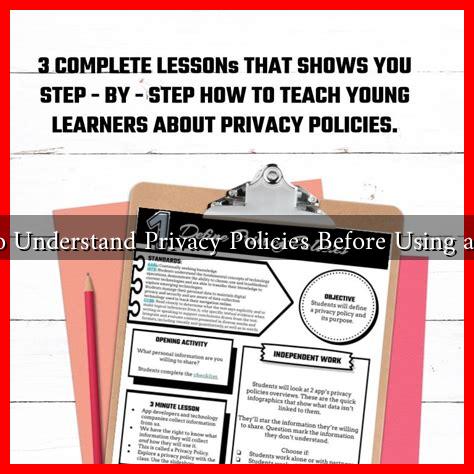-
Table of Contents
How to Understand Privacy Policies Before Using an App
In an age where digital interactions are ubiquitous, understanding privacy policies has become essential for users of mobile applications. Privacy policies outline how apps collect, use, and protect user data. However, these documents can often be lengthy and filled with legal jargon, making them difficult to comprehend. This article aims to demystify privacy policies and provide practical tips for users to better understand them before downloading and using an app.
The Importance of Privacy Policies
Privacy policies serve as a crucial line of defense for users, detailing how their personal information is handled. With increasing concerns over data breaches and misuse of personal information, understanding these policies is more important than ever. Here are some key reasons why:
- Data Protection: Privacy policies inform users about what data is collected and how it is used, helping them make informed decisions.
- Legal Compliance: Apps are required by law to disclose their data practices, ensuring transparency.
- Trust Building: Clear and concise privacy policies can enhance user trust and loyalty towards an app.
Breaking Down Privacy Policies
To effectively understand a privacy policy, users should focus on several key components:
- Information Collection: Look for sections that explain what types of data are collected, such as personal information (name, email), usage data (how you interact with the app), and location data.
- Data Usage: Understand how the app intends to use your data. Common uses include improving services, personalizing content, and marketing.
- Data Sharing: Check if the app shares your data with third parties, such as advertisers or partners. This section often reveals the extent of data exposure.
- Data Security: Look for information on how the app protects your data, including encryption methods and security protocols.
- User Rights: Familiarize yourself with your rights regarding your data, including access, correction, and deletion options.
Practical Tips for Understanding Privacy Policies
Here are some practical tips to help you navigate privacy policies more effectively:
- Skim for Keywords: Use keywords like “data collection,” “third-party sharing,” and “user rights” to quickly locate relevant sections.
- Use Online Tools: Websites like PrivacyTools provide summaries and analyses of privacy policies, making it easier to understand complex terms.
- Check for Updates: Privacy policies can change frequently. Always check for the latest version before using an app.
- Look for User Reviews: User reviews can provide insights into how an app handles privacy and data security in practice.
Case Studies: Real-World Implications
Understanding privacy policies can have real-world implications. For instance, in 2020, the popular video conferencing app Zoom faced scrutiny over its privacy practices. Users discovered that their data was being shared with third parties without adequate disclosure in the privacy policy. This led to a significant backlash and prompted Zoom to revise its privacy policy to enhance transparency and user trust.
Another example is the Cambridge Analytica scandal, where Facebook users’ data was harvested without consent. This incident highlighted the importance of understanding privacy policies, as many users were unaware of how their data was being used and shared.
Conclusion
In conclusion, understanding privacy policies is crucial for anyone using mobile applications. By focusing on key components, utilizing practical tips, and being aware of real-world implications, users can make informed decisions about their data privacy. As technology continues to evolve, staying informed about privacy practices will empower users to protect their personal information effectively. Always remember: a well-informed user is a safer user.

